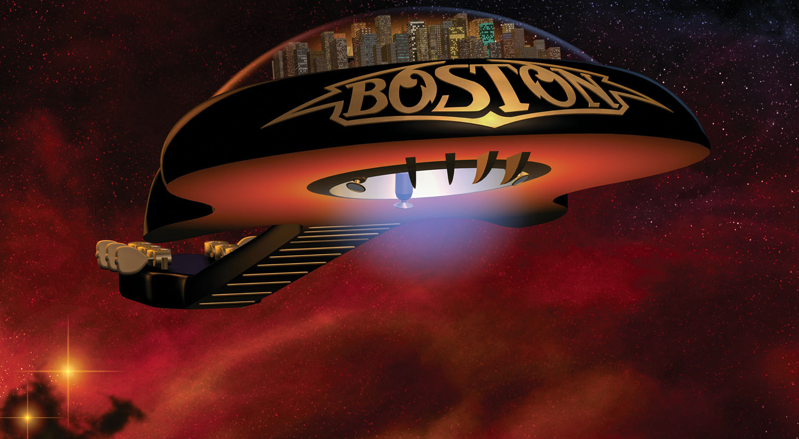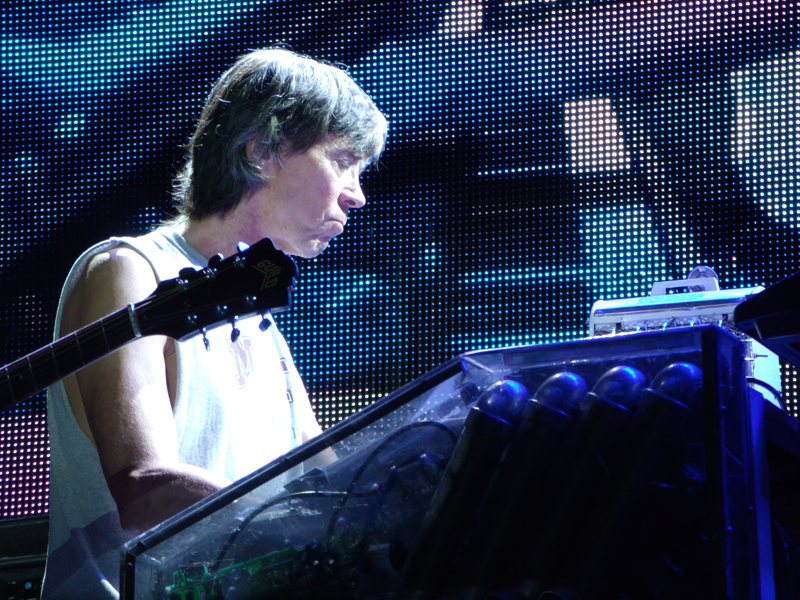Life, Love & Hope: Tom Scholz Talks Gear, the Wonders of Analog Recording and Boston's New Album

Boston’s Tom Scholz has been blazing ground with new technology since before the band’s groundbreaking self-titled debut album in 1976.
Scholz has remained the foundation of the band for more than 37 years and, along the way, has composed and recorded countless rock staples and developed his line of Rockman guitar products.
One thing that hasn’t changed is Scholz’s approach to recording. In this age of Pro Tools and Garageband, when results often can be quick, Scholz prefers his tried-and-true methods of analog recording. The results can be heard on Boston's new album, Life, Love & Hope.
We recently got inside the head of the mastermind to talk about the process.
GUITAR WORLD: The new Boston album, Life, Love & Hope, sounds fantastic. How did this particular collection of songs came together?
That’s a long story [laughs]. Pretty much the same way I’ve done all the Boston albums, which was I started with an idea for a song, maybe a chord progression or a lick for the chorus or verse. I’ll start with that on tape and then sort of see where it takes me. It's an iterative process, definitely not step by step.
Every time I put something down, I get a million more ideas of where it could go from there or how it could be done differently. I don’t try them all but I do try a lot. Once I have a rhythm guitar track and a drum track down, I will start a bass track and pretty soon I realize if I use a different chord form I could maybe do a different bass line, so I have to go back and redo parts.
All the latest guitar news, interviews, lessons, reviews, deals and more, direct to your inbox!
Each new layer I put on adds a new world of options and possibilities. It’s a mathematical progression that expands at an exponential rate. By the time I’m done with a song after months and months, assuming it’s one that ends up on the album, 99 percent of what I’ve recorded doesn’t make it on the final track. I describe it three steps forward and 2.9 steps back.
Obviously the technology of recording has changed tremendously since Boston’s 1976 debut album.
For some people! [laughs]
Has your process changed at all, or do you still do it like you did it in the 1970s?
There is one change. Regrettably at the end of the process I have to do a conversion from analog to digital. I have to deal with what that does and do maybe some editing. Typically I will spend three to six months recording a particular song. As I’m going along, I have versions and incarnations.
I like to relax a minute at the end of the day and let the tape play. I really enjoy that. But in that last step in converting to digital, even “good” digital at 24 bit, after a few hours I don’t want to hear the song anymore. It’s an agonizing process for me. It’s heartbreaking. What I hear is fantastic. It sounds spacious and beautiful. Then it gets converted to digital and sounds like crap. I can’t do anything about it.
However, I have made a series of mixes that are completely analog. So for most of the songs all analog versions. I’m just in the process of finishing that up and we will be releasing this on vinyl, which will be completely analog. I’m very much looking forward to that. I’m not sure if there are any other analog recordings on vinyl these days. It sounds great. I can’t stand digital. I can't stand listening to it. If I had to record in digital, I would stop.
When the label put out the first few Boston albums on CD, you would get them and think it was the newest and greatest technology. But at the end of the day, you ended up back at the record because it sounded much fuller. I can’t imagine how good these new songs sound to you because they sound so great even on the CD.
Thank you. I work as hard as I can to make it work with this digital format, but it's always a big step down for me. Analog can’t be beat. There are three technical reasons digital is not as good as analog. Clearly it bothers some people a lot more than others. Some people look at me like I have two heads when I say it bothers me. Others couldn’t agree more and can’t stand it.
Of course, to add insult to injury, they added compression. They compress the files and make these ghastly mp3 files everybody loads onto their iPods. I can’t imagine that. I can’t stay in the same room when someone plays one of those. When somebody puts their downloaded stuff on the sound system where I skate at, I’ve been known to leave [laughs]. I can’t take it.
It’s more than just the sound. Probably the record-buying audience is too young at this point to appreciate what vinyl and cassettes sound like in comparison to CD’s, but also you guys were always known for amazing artwork on album covers and the liner notes. That seems to becoming a lost art.
Yes, people really latched on to this whole “more is better” thing online where you grab a song from here and a song from there. The whole experience of getting an album from an artist you like and listening to it from beginning to end is sort of gone. Now it’s piecemeal.
The best most artists can hope for is a “greatest hits.”
The only two rays of hope are that there are this group of people setting up to play vinyl. One of the most promising parts is that those people aren’t all older adults. They are college kids. When I was in college, that generation created the market for great audio sound. That was the generation that started buying stereo LP’s and power amps and all these things to have great audio.
Somewhere, that got lost along the way many years ago. College kids were at the front of the line for downloading junk off the Internet in any cheap way possible. It’s really good to see that there is a start of that movement toward quality. The other thing is, although I’ll probably never be a fan, there is finally a provider that has started to offer higher-resolution digital copies with a much higher sampling rate. That was my biggest complaint about CD’s.
When you were putting these songs together, you used almost every vocalist who has ever been on a Boston album. When you were writing, did you say to yourself, “This one is good for Brad” or “This one would be great for Tommy?"
It’s not easy. Of course, if Brad were here I would have him singing a lot more songs. I really have to guess at it. I don’t always get it right. The last song, “The Way You Look Tonight," I had four different singers sing it all the way through, complete with editing, before I finally got the right one. It turned out to be Tommy DeCarlo. So many other ones I have gotten lucky and got it right off the bat. Tommy did a great job on several of the cuts.
I have Kimberley Dahme on “If You Were In Love." I wrote the lyrics for a female voice because I thought it would be a good range for her. I’d planned on doing the harmonies with male voices behind her. When I heard her actually sing it and she sang the harmonies for the second verse, I was knocked out. That was the only song on the album that is sung by one voice. All the other songs have more than one vocalist. That’s one of my chance songs. I stuck my neck out on that. Obviously there are a lot of people who expect to hear only male voices, but I thought it was the right voice for the song.
The one thing I noticed with this album is that it has a continuity you don’t expect. Seeing it had all these different voices, I almost expected something like the Beatles with the different flavors depending on the singers.
It was intentional, of course. I’m lucky the style of all of these singers is very similar. Obviously me singing a song was a departure [laughs]. I’ve been showing singers for more than 30 years how to sing my songs. I figured it was time I just did one.
How many guitar tracks are we typically listening to on these new tracks?
A lot! What I’m after is always that choral or orchestral effect. There are a couple of important things I have to keep in mind when I’m doing that. If there is an electric guitar, there are almost always two. Very frequently I will double up the track on each side, the left and the right. The difficult things with rhythm guitars is that they can't be tuned exactly the same. They have to have a difference in pitch. You have to play it enough that the guitar is naturally de-tuned. The pitch has to be intentionally altered.
When you start to get up into larger numbers, like four guitars, you have to be off, but you can’t get too far off. This is nothing new. I started doing this from the very beginning. For example, “More Than a Feeling,” that last chorus has four electric guitars, two on each side, de-tuned as I described. There are then three lead guitars. Leads are a completely different story. There you have to be careful in the other direction. The tuning must be very, very close. The playing should be slightly off time.
When you get into bending a string and doubling it, it can get to be a little scary. It takes a lot of work to get it right. When we do it live we have three guitars, and it takes a lot of work. That’s a very long answer to a very short question. Typically eight for a rhythm, and if there is a lead then anywhere between two and six.
Are you looking at 2014 for a possible tour?
We are looking into it. We don’t have any firm plans, but it looks very promising. We are basically full speed ahead. We did 50 dates in 2012 but we never made it left of the Rocky Mountains, so we had best start out west. We are going to try not to leave anyone out this time.
Can you talk about the process of creating the Gibson #10 Tom Scholz 1968 Les Paul? Do they work with you or do you sort of hand them your baby and see what they come back with?
No, there was a lot of back and forth. I stayed with them while they were measuring the first time. They took a lot of care and it was a serious scientific endeavor that I was really impressed with. They came back with a rough prototype and I picked it up and immediately noticed some things and did my own measuring and sent them back a whole list of error corrections or what have you. They, with dogged determination, got the physical properties of that guitar exact. If I picked up my main guitar and that guitar, I couldn’t tell you which one I was holding. They did a remarkable job. I was pretty impressed.
It has to be intimidating for a luthier to go to you in particular knowing the amount of knowledge you have and have to make something to your standards.
They really did a great job. They put a lot of effort into it and I was amazed at how good visually it is. They got all the knicks and the bumps.
That might be the hard part.
I think so. I’m thinking how do they do that. Do they make a drawing for that.
Boston’s new album, Life, Love & Hope, will be available in the US December 3 via Frontiers Records. Visit bandboston.com for more information and future tour dates.
John Katic is a writer and podcaster who founded the Iron City Rocks Podcast in 2009. It features interviews with countless rock, hard rock, metal and blues artists. In 2013, he started Heavy Metal Bookclub, a podcast and website devoted to hard rock and metal books.












